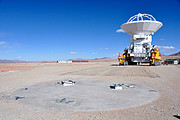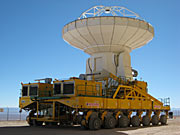The ALMA Transporters: Otto and Lore
The ability to reposition its antennas is part of what makes ALMA such a powerful telescope. The antennas, which are constructed from state-of-the-art precision components, each weigh over 100 tons, so moving them around requires specially designed vehicles. Engineers had to design vehicles rugged and durable enough to transport an antenna safely along the 28-kilometre road from the Operations Support Facility at an altitude of 2900 metres to the Chajnantor plateau at an altitude of 5000 metres, as well as to move them to new positions on the plateau as necessary.

ALMA uses two of these enormous transporters, which have been named Otto and Lore. The twin vehicles are 20 metres long, 10 metres wide and 6 metres high, and each has 28 tyres. Even empty, the vehicles weigh in at 130 tonnes apiece. It takes a lot of power to move that much weight, so each vehicle comes equipped with two approximately 700-HP (500 kW) diesel engines and two 1500-litre fuel tanks. Despite their bulk and power, these bright yellow behemoths will be able to position the antennas to within a few millimetres, ensuring accurate placement on the antenna foundation pads. They are used to arrange the 50 12-metre diameter antennas of the main array in patterns spread over distances from 150 metres to about 16 kilometres.
Many unique design challenges were met in constructing Otto and Lore. A custom braking system and special safety devices are installed to protect against accidents and damage to the valuable ALMA antennas. The backrest of the driver’s seat is shaped to allow him or her to wear the oxygen tank needed for high altitude driving. It is not just the driver who feels the effect of the altitude: each of Otto and Lore’s 700-HP engines actually generate about 450 HP (320 kW) when working in the rarefied air of the 5000-metre high plateau.
The transporters have a top speed of 20 km/h, or 12 km/h when carrying an antenna. They may not be very fast, but the main concerns in their design are safety and precision. During loading and unloading of an antenna, or other critical manoeuvres, the transporters can be operated by a radio remote control, allowing the driver to stand outside the vehicle and keep a close eye on the machinery.
Without these impressive machines to carry its antennas, ALMA would be impossible. A modern observatory requires a combination of many different state-of-the-art technologies. Otto and Lore are playing their important role in the enormous and exciting ALMA project.
